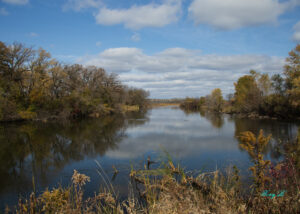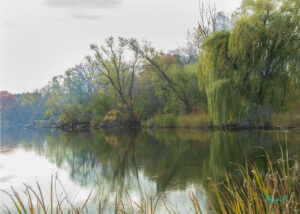Salinization from anthropogenic activities threatens freshwater lakes and rivers. Freshwater bodies are habitats for hundreds of species that are in danger of losing their habitat due to salinization. Natural nutrient cycling leads to controlled salinity levels and concentrations–however, lakes and rivers connected to areas of high-impact human activities such as urbanization or agriculture are at an increased risk of salinization.

Yahara River (Credit: Tony Basilio via Flickr CC BY 2.0)
Transport rates are highly controlled by biogeochemical and hydrological processes that may lead to the retention of salt as opposed to the transfer. In this sense, lakes can act as sinks or sources of solutes like salt. All to mean that lakes that are exposed to high influxes of salt will have higher concentrations of salinity that can then be dispersed to the rest of the watershed.
Anthropogenic activities like salting roads and the use of synthetic fertilizers can lead to nutrient loading that negatively impacts aquatic systems. Salinization can impact the biotic functioning of organisms, trigger trophic cascades, lead to more frequent and harmful algal blooms, and lead to prolonged or permanent anoxic conditions.1 A 2023 study published in Limnology and Oceanography examined “salt export along a river–lake continuum to investigate the anthropogenic drivers, temporal dynamics and modulators of freshwater salinization.”1
Methods
The researchers used high-frequency in situ monitoring to assess specific conductance–discharge relationships, chloride concentrations and fluxes and the role of lakes in downstream salt transport. In-situ Onset HOBO U24 loggers were used to continuously monitor conductivity and water temperature every 30 minutes.
The Upper Yahara River Watershed in southern Wisconsin was selected as it is a mixed urban and agricultural watershed. The lakes’ chloride concentrations have risen from a little more than 5 mg in the 1940s to approximately 50–80 mg in 2021, likely as a result of urbanization and other anthropogenic activities.

Yahara River (Credit: Tony Basilio via Flickr CC BY 2.0)
Results
Results suggest specific conductance discharge depends on land use, with urban areas exhibiting more frequent mobilization events during stormflow and agricultural areas exhibiting predominantly dilution dynamics. The driving contributors of chloride loading are hydrology and watershed size, whereas concentrations and yields are a result of anthropogenic drivers like urbanization and industrialization.
Understanding salinization and salt transport regimes in lakes and rivers is important for resource managers and future development. Salinization can lead to long-lasting damage to aquatic systems that exceed ecotoxicity thresholds. Understanding the spatial and temporal behaviors of freshwater salinization provides insights into chloride ecotoxicity and the habitability of aquatic environments in urban and rural watersheds.
Sources
- Rock, L.A. and Dugan, H.A. (2023), Lakes protect downstream riverine habitats from chloride toxicity. Limnol Oceanogr. https://doi.org/10.1002/lno.12340



